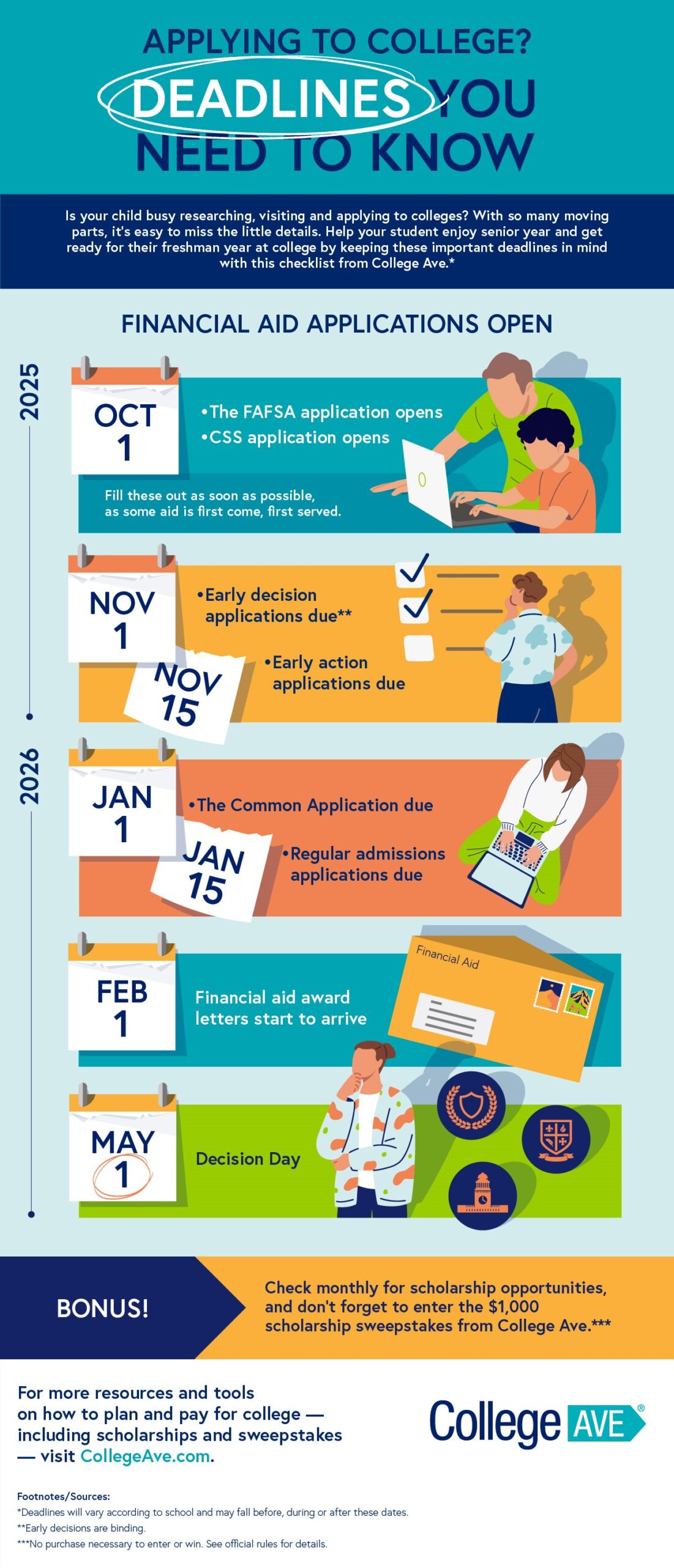2025-10-02T06:01:00
(BPT) – During these times of economic change, Fidelity’s 2025 College Savings and Student Debt Study shows that 60% of parents worry market uncertainty could impact their ability to pay for their child’s education. According to the report, these economic uncertainties are affecting how parents and students are looking ahead, affecting everything from how parents view financial planning to students adjusting their future goals.
To help parents and students consider their options, Chandler Riggs, vice president, financial consultant at Fidelity Investments, answers questions about the study and explains how families can better prepare for the future.
What are the biggest takeaways from the 2025 College Savings and Student Debt Study?
“Fidelity’s 2025 College Savings & Student Debt Study highlights a clear shift toward practicality in how families approach planning and saving for higher education. Students are increasingly focused on affordability and career readiness, with nearly half citing cost as the most important factor when deciding when and where to pursue higher education. At the same time, parents are staying the course on their college savings despite recent market uncertainty, with many leveraging 529 plans to save. Encouragingly, families are having more conversations about how they’ll finance college, but the study also reveals persistent gaps in understanding student debt, which could lead to families underestimating their true financial burden after graduation.”
Why are students getting more practical about college?
“Living through recent times of economic uncertainty is the primary experience shaping how students view higher education today. Nearly half of college-bound students now say cost is “most important” when choosing where or how to pursue higher education. The number of high schoolers who say they’re most likely to consider vocational or technical school after graduation has also increased three times compared to 2021.
Overall, increased awareness of cost is causing students who are approaching the age of making decisions about college and future responsibilities to be more thoughtful about those decisions.”
What should parents keep in mind when planning for college?
“The first thing parents need to do is create a concrete plan for financing your child’s education. If you don’t have a plan, a financial professional like me can help you create one.
Second, talk with your children about realistic expectations and strategies for managing the cost of college. The Fidelity study showed an encouraging growth in these discussions, with nearly 70% of students and parents saying they’ve discussed how they’ll finance their education.
Finally, consider saving in a tax-advantaged account like a 529 college savings plan. The study showed that parents who plan to finance their child’s higher education with a dedicated college savings account report feeling positive, with over half saying they’re optimistic their child will be able to pursue higher education thanks to their savings.”
Is economic uncertainty changing the way parents save?
“Yes — more than half of parents we surveyed say they’re concerned about market uncertainty impacting their ability to finance their child’s college education. Despite those concerns, nearly three-fourths of parents say they’re staying the course when it comes to saving for college.
Among those who have made changes in response to recent market uncertainty, their top actions involve reducing how much they’re saving, or rebalancing or reallocating their investments to manage risk.
As a financial consultant, this is one of the key areas I support my clients on. We always look at when they need the funds when considering the asset allocation for their portfolio. If you won’t need your 529 funds for a while, you might consider allowing for more risk in your asset mix to increase your potential rate of return. Conversely, if you need the funds in the short term, consider a less risky asset allocation to help lessen potential anxiety during periods of market volatility.
Regardless of your time horizon or current economic conditions, it’s important to remember to rebalance your portfolio. If you prefer staying hands off with your investments, an Age-Based portfolio that automatically adjusts the asset allocation based on your beneficiary’s age could be a good option.”
How do 529 savings plans help pay for education?
“529 savings plans are flexible, tax-advantaged accounts designed specifically for education savings. These accounts can be used for a wide variety of education expenses, including college expenses, up to $10,000 per calendar year in expenses for K-12 schools ($20,000 for expenses beginning in taxable years after December 31, 2025), certain apprenticeship costs and even student loan repayments (up to $10,000).[1] And if you’re wondering about unused funds, worry not. Under certain conditions, you can transfer tax- and penalty-free up to a lifetime limit of $35,000 in a 529 to a Roth IRA opened by the 529 beneficiary, making these accounts a helpful option regardless of your child’s plans for higher education.[2]
If your child does choose to go to college, funds from a 529 plan can be used for tuition, fees, books, supplies and approved study equipment including computer technology, related equipment and software, plus internet access or related services used by the student while enrolled at an accredited postsecondary institution. Students enrolled at least half-time may also use 529 funds for room and board expenses.
Many families worry saving for college will hurt their chances of receiving financial aid, but because 529 savings plan assets are considered parental assets, they are factored into federal financial aid formulas at a maximum rate of about 5.6%.
Most importantly, when used for these qualified purposes, 529 plan withdrawals are not subject to federal income tax. Each plan is sponsored by an individual state, often in conjunction with a financial services company, like Fidelity, that manages the plan. Although you don’t have to be a resident of a particular state to invest in its plan, you should check with your home state first for any benefits it may offer.”
Learn more about how to plan and save for your child’s education at Fidelity.com/529, or call 1-800-544-1914 for complimentary access to dedicated college planning representatives.
Please carefully consider the plan’s investment objectives, risks, charges, and expenses before investing. For this and other information on any 529 college savings plan managed by Fidelity, contact Fidelity for a free Fact Kit, or view one online. Read it carefully before you invest or send money.
**Units of the portfolios are municipal securities and may be subject to market volatility and fluctuation.**
Keep in mind that investing involves risk. The value of your investment will fluctuate over time, and you may gain or lose money.
Fidelity Investments and Fidelity are registered service marks of FMR LLC.
Views expressed are as of the date indicated, based on the information available at that time, and may change based on market or other conditions. Unless otherwise noted, the opinions provided are those of the speaker or author and not necessarily those of Fidelity Investments or its affiliates. Fidelity does not assume any duty to update any of the information.
Fidelity Brokerage Services LLC, Member NYSE, SIPC
900 Salem Street, Smithfield, RI 02917
Fidelity Distributors Company LLC
900 Salem Street, Smithfield, RI 02917
National Financial Services LLC, Member NYSE, SIPC
245 Summer Street, Boston, MA 0211
1225760.1.0
© 2025 FMR LLC. All rights reserved.
[1] 529 distributions for qualified education expenses are generally federal income tax free. 529 assets may be used to pay for (i) qualified higher education expenses, (ii) qualified expenses for registered apprenticeship programs, (iii) up to $10,000 per taxable year per beneficiary for tuition expenses ($20,000 for expenses beginning in taxable years after December 31, 2025) in connection with enrollment at a public, private, and religious elementary and secondary educational institution. Although such assets may come from multiple 529 accounts, the $10,000 qualified withdrawal ($20,000 beginning in taxable years after December 31, 2025) limit will be aggregated on a per beneficiary basis. The IRS has not provided guidance to date on the methodology of allocating the $10,000 annual maximum ($20,000 beginning in taxable years after December 31, 2025) among withdrawals from different 529 accounts, (iv) amounts paid as principal or interest on any qualified education loan of a 529 plan designated beneficiary or a sibling of the designated beneficiary. The amount treated as a qualified expense is subject to a lifetime limit of $10,000 per individual. Although the assets may come from multiple 529 accounts, the $10,000 withdrawal limit for qualified educational loans payments will be aggregated on a per individual basis. The IRS has not provided guidance to date on the methodology of allocating the $10,000 annual maximum among withdrawals from different 529 accounts, and (v) tuition, fees, books, supplies, and equipment required for the enrollment or attendance in a recognized postsecondary credential program as defined under Section 529 of the Code and identified by the Secretary of the Treasury as being such a reputable program. Any earnings on distributions not used for qualified higher educational expenses or that exceed distribution limits may be taxed as ordinary income and may be subject to a 10% federal tax penalty. Some states do not conform with federal tax law. Please check with your home state to determine if it recognizes the expanded 529 benefits afforded under federal tax law, including distributions for elementary and secondary education expenses, apprenticeship programs, postsecondary credentialing programs, and student loan repayments. You may want to consult with a tax professional before investing or making distributions.
[2] Beginning January 2024, the Secure 2.0 Act of 2022 (the “Act”) provides that you may transfer assets from your 529 account to a Roth IRA established for the Designated Beneficiary of a 529 account under the following conditions: (i) the 529 account must be maintained for the Designated Beneficiary for at least 15 years, (ii) the transfer amount must come from contributions made to the 529 account at least five years prior to the 529-to-Roth IRA transfer date, (iii) the Roth IRA must be established in the name of the Designated Beneficiary of the 529 account, (iv) the amount transferred to a Roth IRA is limited to the annual Roth IRA contribution limit, and (v) the aggregate amount transferred from a 529 account to a Roth IRA may not exceed $35,000 per individual. It is your responsibility to maintain adequate records and documentation on your accounts to ensure you comply with the 529-to-Roth IRA transfer requirements set forth in the Internal Revenue Code. The Internal Revenue Service (“IRS”) has not issued guidance on the 529-to-Roth IRA transfer provision in the Act but is anticipated to do so in the future. Based on forthcoming guidance, it may be necessary to change or modify some 529-to-Roth IRA transfer requirements. Please consult a financial or tax professional regarding your specific circumstances before making any investment decision.































